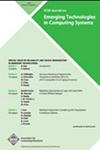2DMAC: A Sustainable and Efficient Medium Access Control Mechanism for Future Wireless NoCs
IF 2.6
4区 计算机科学
Q3 COMPUTER SCIENCE, HARDWARE & ARCHITECTURE
引用次数: 0
Abstract
Wireless Network-on-Chip (WNoC) requires a Medium Access Control (MAC) mechanism for an interference-free sharing of the wireless channel. In traditional MAC, a token is circulated among the Wireless Interfaces (WIs) in a Round Robin manner. The WI with the token holds the channel for a fixed number of cycles. However, the channel requirement of the individual WIs dynamically changes over time due to the varying traffic density across the WNoC. Moreover, the conventional WNoCs give equal importance to all the traffic taking the wireless path and transmit it in an oldest-first manner. Nevertheless, the critical data can degrade the system performance to a large extent by delaying the application runtime if not served promptly. We propose 2DMAC, which can change the token arbitration pattern and tune the channel hold time of each WI based on its runtime traffic density and criticality status. Moreover, 2DMAC prioritizes the critical traffic over the non-critical traffic during the wireless data transfer. The proposed mechanism improves the wireless channel utilization by 15.67% and the network throughput by 29.83% and reduces the critical data latency by 29.77% over the traditional MAC.2DMAC:一种适用于未来无线节点的可持续高效的介质访问控制机制
片上无线网络(WNoC)需要介质访问控制(MAC)机制来实现无线信道的无干扰共享。在传统的MAC中,令牌以循环方式在无线接口(WIs)之间循环。带有令牌的WI将通道保持固定数量的循环。然而,由于整个WNoC的流量密度变化,各个WIs的信道需求会随着时间的推移而动态变化。此外,传统的WNoCs对采用无线路径的所有业务给予同等的重视,并以最古老的第一方式进行传输。然而,如果不及时提供服务,关键数据可能会延迟应用程序运行时间,从而在很大程度上降低系统性能。我们提出了2DMAC,它可以根据每个WI的运行时流量密度和关键状态来改变令牌仲裁模式并调整其信道保持时间。此外,在无线数据传输期间,2DMAC将关键业务优先于非关键业务。与传统MAC相比,该机制将无线信道利用率提高了15.67%,网络吞吐量提高了29.83%,并将关键数据延迟降低了29.77%。
本文章由计算机程序翻译,如有差异,请以英文原文为准。
求助全文
约1分钟内获得全文
求助全文
来源期刊
CiteScore
4.80
自引率
4.50%
发文量
86
审稿时长
3 months
期刊介绍:
The Journal of Emerging Technologies in Computing Systems invites submissions of original technical papers describing research and development in emerging technologies in computing systems. Major economic and technical challenges are expected to impede the continued scaling of semiconductor devices. This has resulted in the search for alternate mechanical, biological/biochemical, nanoscale electronic, asynchronous and quantum computing and sensor technologies. As the underlying nanotechnologies continue to evolve in the labs of chemists, physicists, and biologists, it has become imperative for computer scientists and engineers to translate the potential of the basic building blocks (analogous to the transistor) emerging from these labs into information systems. Their design will face multiple challenges ranging from the inherent (un)reliability due to the self-assembly nature of the fabrication processes for nanotechnologies, from the complexity due to the sheer volume of nanodevices that will have to be integrated for complex functionality, and from the need to integrate these new nanotechnologies with silicon devices in the same system.
The journal provides comprehensive coverage of innovative work in the specification, design analysis, simulation, verification, testing, and evaluation of computing systems constructed out of emerging technologies and advanced semiconductors

 求助内容:
求助内容: 应助结果提醒方式:
应助结果提醒方式:


